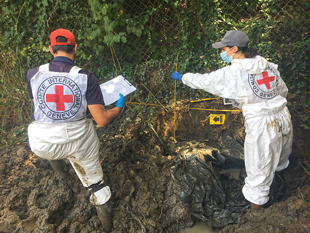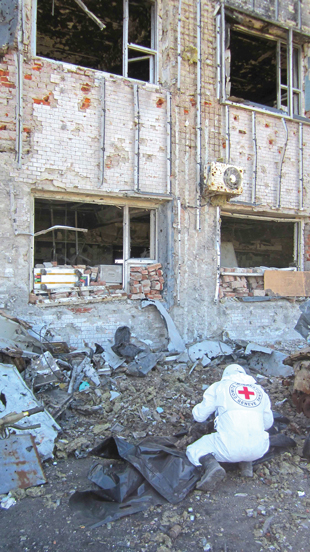The Recovery of Human Remains in Weapon-Contaminated Settings: Towards Guidance for the Mine Action Community
By Lou Maresca, Chris Poole, and Jane Taylor, PhD [ International Committee of the Red Cross ]
CISR JournalThis article is brought to you by the Center for International Stabilization and Recovery (CISR) from issue 25.3 of The Journal of Conventional Weapons Destruction available on the JMU Scholarly Commons and Issuu.com.
Mine action and forensic services are critical elements in the response to humanitarian needs during and after armed conflict. Mine action operators will work to identify, mark, and eventually clear areas contaminated with landmines and explosive remnants of war (ERW). Forensic specialists and other related experts will be operational in the search for missing persons and the management of the dead by locating, recovering, and helping to identify human remains, while ensuring maximum protection, dignity of the deceased, and attention to their families.¹ These professions can often intersect in situations where human remains and explosive hazards are both present.
It is not uncommon for mine action operators to come across human remains in clearance or explosive ordnance disposal (EOD) activities. This often occurs when such remains are located in a suspected or a confirmed hazardous area or in an assessment of structures damaged during a conflict. There are also times when an operator is requested to assist a human remains recovery operation if mines or ERW are found or believed to be present in the area of excavation and exhumation.
The work of forensic practitioners will sometimes need to take place in weapon-contaminated settings. For instance, it may be necessary to search for and exhume sub-surface remains in areas where mines and ERW are present. Another example is surface recovery, which involves recovering remains from an open area or within a collapsed structure following an explosion.2 The recovery of deceased combatants can be particularly hazardous, as many will have been killed with explosive ordnance on their person, and in some contexts the remains of enemy combatants have been booby trapped, presenting additional explosive hazards to humanitarian forensic personnel and first responders.
Although each profession operates within its own set of professional standards and best practices,3 they also operate under an overarching framework of law, religious customs, and additional moral and ethical considerations, which must be taken into account in each individual situation.
International humanitarian law (IHL) is one of these frameworks. Under this law, all parties to the conflict are required to respect and provide for the proper management of the deceased. The Geneva Conventions, their Additional Protocols, and customary IHL contain specific rules on the search for and protection of the deceased; on the treatment of human remains including their burial; on the subsequent documentation and maintenance of gravesites; and on exhumation, examination, identification, and repatriation. Although the rules themselves are primarily directed at the parties involved in an armed conflict, they are often reflected in or influence national legal regulations on the medicolegal death investigation systems and management of human remains that must be taken into account. In many instances, however, the relevant state entities, including national mine action authorities (NMAAs), are not aware of these requirements or do not have in place the necessary procedures and practices to ensure that they are followed. There have been cases where human remains have been broken apart or buried without forensic identification or means of traceability, and without consideration of local cultural or religious methods and sensitivities.
Ethiopia and Eritrea: From 2001 to 2002, several demining organizations were operating on the border between the two countries. This was a time when some governments favored bilateral aid packages and programs that involved heavy equipment. As a result, mine action organizations were under pressure to configure and build operations around flails and other capital-intensive machines. During one operation, a flail deployed to clear anti-personnel and anti-vehicle mines uncovered human remains in shallow graves. Unfortunately, it took some time for the operator to realize what was happening. The machine damaged forensic evidence and separated body parts and artefacts, making identification almost impossible.
Guidance to Support Forensic/EOD Operations
There is a need to generate better understanding, planning, and coordination with regard to the recovery of human remains in weapon-contaminated settings. It was with this in mind that the International Committee of the Red Cross (ICRC) published a set of guidelines on this topic in 2019 called The Recovery of Human Remains in Weapon-Contaminated Settings.4 This guide aims to help both the mine action and forensic services sectors, including first responders, better understand the issues involved when both human remains and explosive hazards are present, and develop appropriate responses in a deliberate and collaborative manner whenever possible. The guide primarily addresses situations where forensic and EOD operations are available and where both are able to plan and work collaboratively. The main elements of the guidelines can be summarized as follows:
Guiding principles. Joint forensic and EOD operations should operate under three main principles. These principles (1) prioritize the health and safety of staff over human remains recovery (no death is worth another life), (2) the safety of the local communities near operations, and (3) the imperative need to treat the deceased with dignity.
Framework for planning. The guidelines also outline a framework for planning with a focus on key operational practices.
- Assess first, recover second. If there is any doubt as to whether human remains can be recovered safely, operations should not begin until the appropriate expertise is available or until awareness training or other mitigation measures are in place.5
- Establish and maintain a common approach path (i.e., an agreed route in and out) to and from the site of interest. Mine action specialists should ensure that this path is both free from explosives and is located outside the danger zone should a nearby item of ordnance explode. The approach path is also the extraction route in the event of an accident or injury. For this reason, it should be clearly marked using well understood methods, and the medical point should be located near the control point, at the entrance to the approach path.
- Employ context appropriate forensic methods. The forensic procedures must take into account the scope and objectives of the forensic operation, the legal framework of the country, the resources available, and affected families and communities, including religious and cultural considerations.
- Consider forensic objectives and context appropriate EOD procedures. This not only involves how best to safely remove or neutralize the hazard at hand (e.g., in-situ, semi-remote movement, low-order techniques) but also having those decisions informed by the context and the understanding of the likely effect of an explosion during the forensic process and the potential of irreparable damage and loss of information.
- Collaborate to use technical capabilities and skill sets efficiently. It is in the interests of everyone, including local communities and donors, to use enabling capabilities as economically and as efficiently as possible.
Although the bulk of the guidelines are directed at joint or collaborative EOD forensic operations, there are a number of practical steps that can be drawn from them to help mine action operators orient themselves on the issue of human remains located in weapon-contaminated environments.
Anticipate. Every mine action operation should anticipate the issue, whether it is likely to arise from a body being found incidentally in the course of mine clearance or an EOD operation, or when it is requested to support an existing or new human remains recovery operation. Practice has shown that it arises in many contexts and operations.
Prepare a strategy. In every context where human remains are expected or likely to be found, there must be a discussion with the NMAA to ensure a proper understanding of the procedures and expectations as to how any found remains are to be managed and to whom such an event should be reported. This reporting is the basic practice that should be required of all mine action operations.
Assess and plan. Some of the factors that should be considered and assessed as part of an initial planning process include the
- likelihood of human remains being found
- location of the remains, their immediate environment (surface, buried, under collapsed structures, etc.), their likely status (combatant, civilian, etc.), and their likely condition
- types of weapons and extent of contamination in the area (to determine which area of expertise has primacy at which site)
- potential need for specific EOD competence and equipment (e.g., risk of finding deceased combatants booby-trapped or equipped with person-borne improvised explosive devices [PBIED])
- availability of forensic services
- likely duration of a clearance operation in and around the location and the resources required.
There are certainly other elements that must be part of this reflection and which are drawn from the specific situation. Activities related to the management of any human remains found (e.g., reporting, documentation, recovery, collection of personal effects) are also relevant and should be established in the discussions with the NMAA or other relevant authorities and services.
Bosnia and Herzegovina: The presence of mines and ERW in and around gravesites in eastern Bosnia and Herzegovina presented a significant operational challenge in the two decades following the conflict. In one instance, a sub-surface mass grave was covered over with a minefield. This was not thought to be a deliberate act to obscure or block access to the gravesite but rather the reality of rapidly changing frontlines. In such instances, the excavation teams adopted a simple solution: a mine clearance organization would use detectors, dogs, and other means to carry out a surface clearance before the forensic specialists moved in.

ICRC staff searching for human remains Abkhazia/Georgia in 2021.
For thirty years, the ICRC has been helping people in Georgia proper, Abkhazia, and South Ossetia affected by the armed conflicts of the 1990s and August 2008. As part of its action on missing persons and their families, in 2010, the ICRC helped establish two coordination mechanisms6 between the sides with the sole humanitarian purpose to clarify the fate of more than 2,300 persons who were missing in relation to the armed conflicts and to return their remains to their families. With the ICRC acting as neutral intermediary and chair, the coordination mechanisms serve as platforms to exchange information relevant for the search for missing persons, a process which is carried out with local stakeholders trained and supported by the ICRC.
ICRC Weapons Contamination (WeC) experts have supported forensic operations in Abkhazia since 2012. While tens of thousands of mines and unexploded ordnance have been cleared,7 a significant risk from contamination remains.⁸ For this reason, the ICRC has integrated EOD technical elements into its forensic operations in order to ensure the safety of all personnel involved. Additionally, it supports the safe retrieval of human remains for later analysis and, it is hoped, their return to family members.
The collaboration of the ICRC forensic and WeC units provides an excellent example of the collaborative approach outlined in the ICRC guidelines published in 2019. The risks were anticipated, and a strategy prepared. As part of the assessment and planning, standard operating procedures were developed and all staff were appropriately trained. Importantly, the training of local EOD experts from 2019 has also ensured ongoing support and sustainability for the work.
Towards New IMAS Guidance

ICRC recovers human remains at an airport in Donetsk, Ukraine, in 2015.
The International Mine Action Standards (IMAS) already include a Technical Note (TN) on the management of human remains, which provides some guidance to mine action operators.9 This TN, however, is limited to situations where remains are incidentally found during clearance activities and where no forensic support is available, and as a result does not take into account many of the joint planning and multidisciplinary aspects of a collaborative approach that would be required in other situations. In 2019, the ICRC was given a mandate by the IMAS Review Board to prepare a new IMAS chapter and a TN on the recovery of human remains for consideration by the review board. This work is currently being discussed in a Technical Working Group, coordinated by the Geneva International Centre for Humanitarian Demining with support from the ICRC. It is hoped that the results of this work will contribute to a greater awareness of the challenges that arise at the intersection of humanitarian mine action and forensics activities, provide appropriate guidance to address them, and ensure that human remains can be recovered safely and in line with the requirements of IHL as well as other applicable legal rules, religious customs, and moral and ethical considerations. ◊
 Lou Maresca
Lou Maresca
Deputy Head
Weapon Commination Unit
International Committee of the Red Cross
Lou Maresca is Deputy Head of the Weapon Contamination Unit of the ICRC. He joined the ICRC in 1995 and since then has worked on the legal, policy, and operational aspects of the ICRC’s and Red Cross and Red Crescent Movement’s response to landmines, cluster munitions, and explosive remnants of war. His main areas of work currently focus on supporting the ICRC’s weapon contamination programs in the field, coordinating and developing ICRC contributions to the International Mine Action Standards, and working with ICRC delegation’s and National Red Cross Societies’ risk awareness and safer behavior programs.
 Christopher Poole
Christopher Poole
Regional Manager
Weapon Contamination Unit
International Committee of the Red Cross
Christopher Poole is Regional Manager of the Weapon Contamination Unit of the ICRC, based in Moscow, advising on mine action and ammunition management matters in the Eurasia region. Poole has worked in explosive threat mitigation and mine action for over thirty years, initially with the British Army and later with the United Nations and the commercial Counter-IED sector. Most recently, he has worked in the disputed territories of Nagorno Karabakh during the 2020 conflict and in Moldova in early 2022, undertaking an ammunition management program.
 Jane Taylor, PhD
Jane Taylor, PhD
Regional Forensic Manager, Eurasia
International Committee of the Red Cross
Jane Taylor, PhD, is the Regional Forensic Manager for Eurasia for the ICRC. She is a specialist forensic
odontologist with over thirty years’ experience in Australian Disaster Victim Identification responses.

